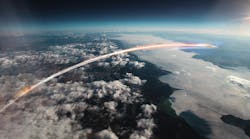NAME: James Klein
TITLE: President of infrastructure and defense products
CO.: New company (TBA) formed by TriQuint and RFMD merger
ROLE: Global supplier of high-performance radio-frequency (RF) solutions and services for defense and aerospace applications
CONTACT: www.triquint.com, www.rfmd.com
TriQuint and RFMD have merged to form a new company (name to be announced) with combined revenue of more than $2 billion, serving the defense/aerospace, network infrastructure, and mobile device communities. Here, a senior manager talks specifically about infrastructure and defense.
What does the merger mean to the aerospace and defense community?
TriQuint has long had a good presence in aerospace and defense, predominantly in radar applications. Putting the companies together creates a leader in the industry with a wide range of products in defense/aerospace and cellular infrastructure.
We are in the process of building synergies, going through the integration process, and we’re off to a good start.
Today at TriQuint, one third of our company revenue, one third of our business today is directly related to defense and aerospace predominantly in the radar market. Our gallium arsenide (GaAs) and gallium nitride (GaN) technologies are used in a variety of defense and aerospace programs; among those that we publically speak about are the F-22 and F-35 military aircraft and ground-based radar systems including the [Lockheed Martin] TPQ-53.
What does RFMD bring to TriQuint? What are the synergies?
TriQuint has a long legacy in the defense market and quite a bit of technology, with GaN and GaAs. There’s a new technology coming to defense, and RFMD brings more access to that technology, called silicon germanium, and a robust packaging capability, so the ability to package the semiconductors in a lower-cost format. We believe that putting these capabilities together will really give a broader portfolio of products that will also help us grow.
Will you expand your market focus?
Radar has been our core, and we will continue to expand into both the defense communications and electronic warfare businesses, as well as extend more into the international marketplace. Both TriQuint and RFMD have a somewhat of an international foothold, but it is a growing business.
We believe that radar will continue to be a focus area for us. We are also focused on the optical driver business; that’s the technology fueling the deployment of optical networks around the world.
Both companies have a presence in base station components. The rollout of LTE base stations around the world is a focus for us and an area where we are winning big.
RFMD brings a great focus on connectivity, WiLan and the Internet of things. That will continue to be a focus going forward. Together we will pursue things like base station power with our GaN technology.
To repeat, radar, optical drivers, wiland, base station and base station power.
With a shrinking U.S. defense budget, will you look to growing internationally?
During this flat time in the defense market, we have actually been able to grow our defense business. We have grown at about 9 percent year over year growth of the defense business – and we have done that really by expanding our product portfolio along with bringing this new technology to bear in gallium nitride.
We have been focused domestically and internationally, and we have increased our international presence. We are seeing significant growth internationally; as an example, last year we grew about 50 percent in Europe. That will continue to be a focus for us, as we see the U.S. defense budgets flattening or slightly down, we will continue to push for a broader international presence.
How has the response to the merger news been thus far?
When we look at the positives of the merge, and we think about customers and employees and our stockholders, we have seen very positive response from all three. As we have reached out to customers across my set of products and markets, we have gotten very good response from the customer base. We have done a significant amount of employee engagements and have gotten a positive response from the employees. Certainly, if you follow our stock, you have seen that we have gotten a good response from our shareholders. So we enter this next phase of integration very positively.
The combination of the two organizations gives us scale, gives us breadth in product portfolio, and will enable us to compete and grow in this infrastructure and defense market area.



